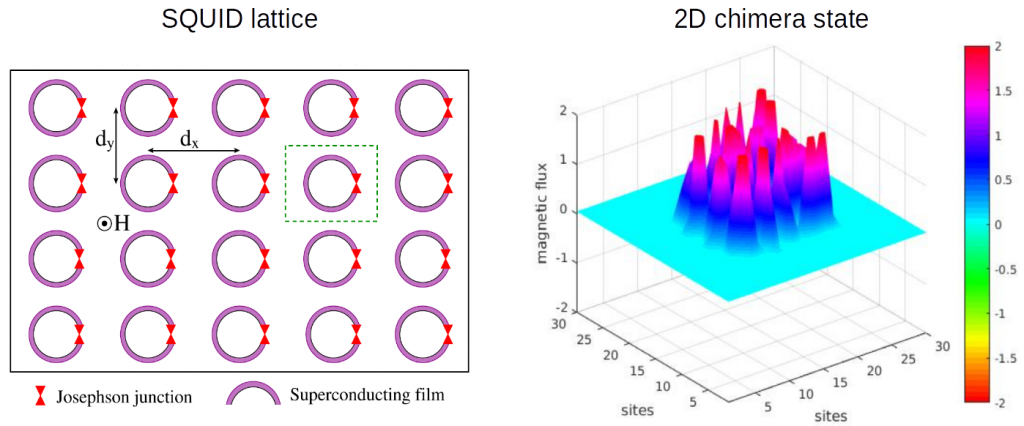The interplay between nonlinearity and structure is at the center of research on complex systems. In ensembles of coupled oscillators, in particular, the synergy between topological features and the underlying dynamics may lead to self-organized phenomena such as synchronization, spatio-temporal patterns and chimera states. In the proposed research, we will study a system that is capable of exhibiting such complex dynamics of collectively emergent behavior: a superconducting quantum-interference device, commonly known as SQUID. When arranged in repeating motifs, SQUIDs form metamaterials, i. e. artificially structured media of weakly coupled discrete elements that exhibit extraordinary properties e. g. negative diamagnetic permeability. The proposed project will involve theoretical modeling in close interaction with experimental activity. The main focus will be on chimera states, a fascinating counter-intuitive symmetry breaking phenomenon of partially coherent and partially incoherent behavior. The increasing number of studies on chimera states is impressive, ranging from physical and chemical, to biological and technological systems. Works on superconducting systems, however, are still largely missing. In many cases, chimeras are known to be chaotic transients or “metastable” states with non-fixed size and position. That makes their experimental verification a challenging task, and the need to control them through various techniques of crucial importance. Moreover, since chimeras have mainly been found in systems of one spatial dimension, there are many open questions concerning higher-dimensional chimera patterns and how to achieve them. To solve these open problems, our proposed project SQUIRREL (SQUId metamateRials: chimeRas and spatio-tEmporaL dynamics) will focus on four main topics of increasing dimensionality and structural complexity: (1) Complex dynamics of the constituents of our metamaterial (single and two coupled SQUIDs); (2) Taming metastable chimeras in one-dimensional SQUID arrays through theoretical and experimental techniques; (3) Chimera state classification in two-dimensional SQUID lattices and experimental imaging of the corresponding patterns; (4) Modeling of a three-dimensional SQUID structure through a multiplex network approach, fabrication of SQUID stacks and imaging of 3D patterns. Since the SQUID metamaterials are the classical prototypes of various types of superconducting quantum computing settings (in which the usual SQUIDs are replaced by their quantum, approximate two-level system counterparts, the qubits), the outcome of the planned research will have significant impact on basic and applied research that is related to the design of novel types of superconducting quantum computing devices.



